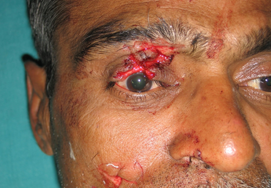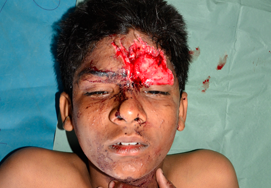Eye Lid Reconstruction
Indicated in all individuals and in a few instances when defects are present

- What is eyelid reconstruction surgery?
- Which individuals are eligible for the surgery?
- Which individuals are not eligible for the surgery?
- How are the defects classified
- How should I prepare for the surgery?
- What will happen during the surgery?
- What can I expect on my day of surgery?
- What is the aftercare of the surgery?
- What are the pros and cons of eyelid reconstruction?
What is eyelid reconstruction surgery?
Eyelid reconstruction is performed in many instances such as after tumor excision or traumatic conditions.
Simple superficial defects in the eyelid may occur after minor trauma or removal of small growths. Many of these require nothing more than local wound care and will heal on their own in a week to 10 days. Some simple superficial defects may require a few sutures with the same local wound care.
Simple sutures can treat many such instances, but in situations that are more complicated, eyelid reconstruction may be required. Larger defects may extend through the entire lid. Many of these can be sutured together directly, but many others may require more complex reconstructions.
In many of these more complex cases, the surgeon will need to use transfer of adjacent tissues (what we call ”flaps”), or transfer of skin from other parts of the eyelid face or body (what we call “skin grafts”) to complete the reconstruction. Some of these more complex reconstructions may require more than one operation to complete (what we call “staged reconstruction”).
The goals of eyelid reconstruction are
- To provide adequate eyelid function
- To afford globe protection
- To achieve acceptable aesthetic results
The functioning upper eyelid serves a more important role in globe protection than the lower eyelid because the upper eyelid covers a greater area of the cornea. The normal vertical excursion of the upper eyelid is approximately 12 mm, compared with 5 mm for the lower eyelid.
In evaluating reconstructive demands for the upper eyelid, the anatomic defects must be carefully appraised. The vertical, horizontal, and depth dimensions of the eyelid injury or defect must be determined, and availability of regional and distant tissue for reconstruction must be evaluated.
Which individuals are eligible for the surgery?
Eyelid reconstruction is indicated in all but a few instances when defects are present. Healing by secondary intention is a viable option when the defect is confined to the medial canthus region. Small defects (< 1 cm) in this concave area heal well by secondary intention. However, involvement of the lacrimal apparatus requires primary reconstruction.
Which individuals are not eligible for the surgery?
Eyelid reconstruction as well as lower eyelid reconstruction has few contraindications. If you are a patient with only one seeing, certain procedures such as Cutler-Beard flap, must be avoided to maintain the ability to retain the vision. The same way in the patients with comorbid conditions, complex and time-consuming reconstructive therapies are contraindicated due to the risks related to heart and lungs.
Reconstruction is indicated for all defects that may lead to secondary complications if not repaired. These complications may include lid notching, epiphora, corneal exposure, and lagophthalmos.
How are the defects classified
Eyelid defects are classified according to size and location. A common way of breaking down full-thickness defects is as follows:
- For young patients (tight lids)
- Small – 25-35%
- Medium – 35-45%
- Large – Greater than 55%
- For older patients (lax lids)
- Small – 35-45%
- Medium – 45-55%
- Large – Greater than 65%
How should I prepare for the surgery?
Before the surgery, your doctor performs a complete physical examination of your eyes and face to ensure that the procedure will be safe and effective.
- Before undergoing any surgery, you must quit smoking, alcohol consumption at least a few weeks before.
- You must avoid stress and should consult the surgeon prior and know about the pros and cons of the surgery.
- You must be well hydrated, and avoid certain drugs such as aspirin, NSAIDs and vitamin supplements.
- You should avoid eating or drinking 8 to 2 hours prior to surgery.
What will happen during the surgery?
Eyelid reconstruction can be performed on your upper eyelids, lower eyelids, or both. Based on the preoperative evaluation your underlying facial muscle structure, bone structure, and the eyebrows symmetry, your surgeon would decide how much skin, muscle, and fat is to be removed. Few precise markings are made that indicates where excess tissues will be removed in your upper eyelids and in your lower eyelids.
In your upper eyelid, an incision is made hidden within the natural fold of the upper eyelid. In the lower eyelid, your surgeon will hide the incision just below your lower lashes. Alternatively, when excess fat is being removed, the incision can be placed inside the lower eyelid. A laser therapy may sometimes be used along with this method to make the lower eyelid skin tight.
Your surgeon will remove the tissue through these incisions using surgical instruments, including scalpels, surgical scissors, radiofrequency cutting devices, and, sometimes, cutting lasers. The other adjustments to correct special problems such as muscle laxity were made. Sutures or tissue adhesives are then applied to smoothen and reconfigure areas around your eyebrows and eyelids. If you have dry eyes, your surgeon will possibly remove less tissue to avoid exposing more of the eye to the air, to avoid worsening of the symptoms.
What can I expect on my day of surgery?
It approximately takes one to two hours for the surgery to complete.
- Your surgeon will administer medications to make you feel comfortable during surgery.
- Local anesthesia along with sedation is commonly used during eyelid surgery, though general anesthesia can be used instead.
- There will be various monitors used to check your blood pressure, heart rate, pulse.
- After your surgery is completed, you will be taken to the recovery area for monitoring the vitals.
- A lubricating ointment will be applied to your eyes to protect them and prevent dryness. The ointment may cause temporary blurred vision.
- You may leave home the next day.
- You must avoid driving your car on own to reach your home.
- Your surgeon will discuss the daily activities that can be carried out, or that must be avoided by you.
What is the aftercare of the surgery?
After the surgery you must be accessible with the following items:
- You should clean your hands well
- You should use clean clothes.
- You can use pain killers based on your doctor’s recommendations
- You must avoid the drugs such as aspirin that causes risk of bleeding
- You must stay at home until your eyelids get healed
What are the pros and cons of eyelid reconstruction?
Pros:
- Your eyelid defect gets repaired
- You have a better vision
- Your orbital globe is protected and well lubricated
- Your cornea is well protected.
Cons:
- It takes time to wait on for the results of your surgery.
- You may have itching sensation near the eyes and dryness following the surgery.
- You may also need a brow lift if your eyebrows droop and you have creases on your forehead.








